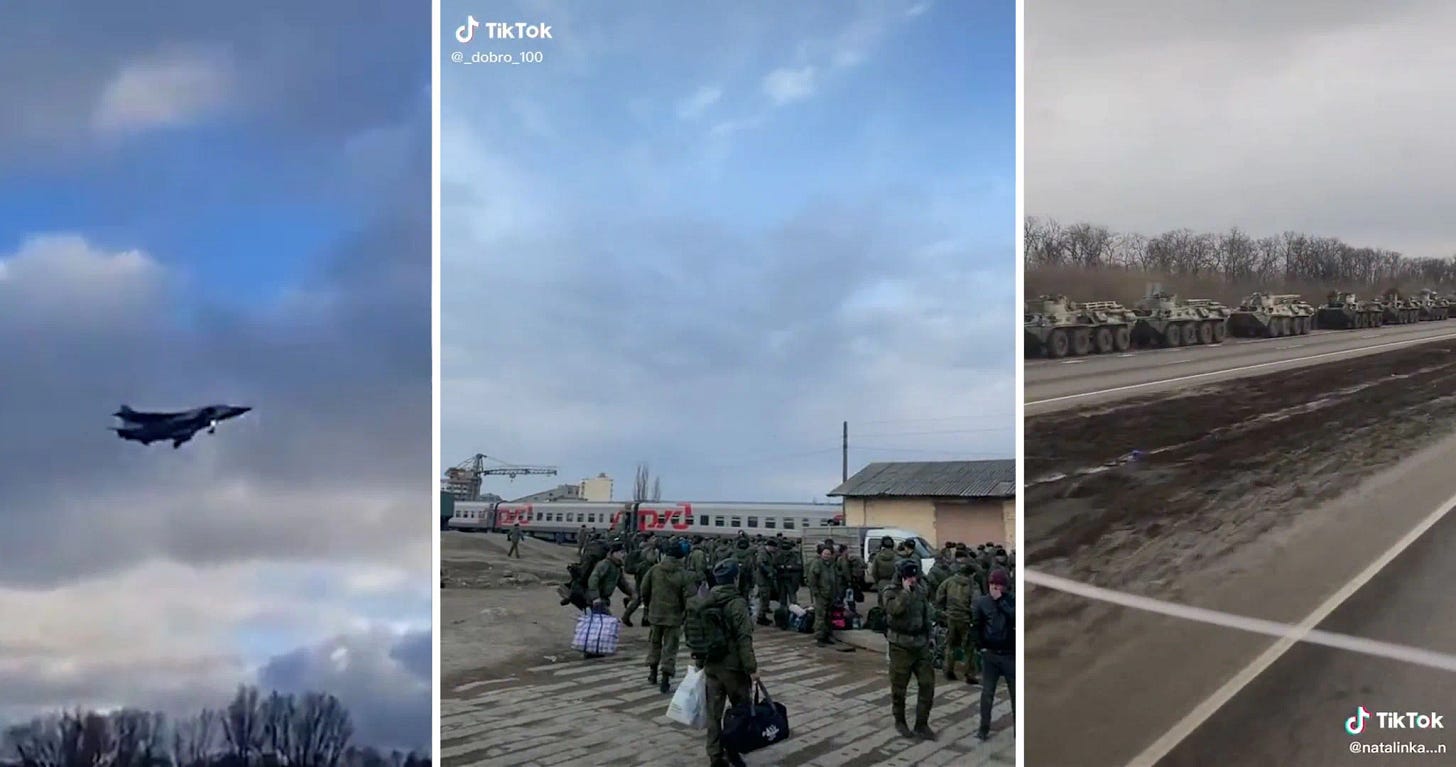Here comes the world's first TikTok war
Russia's invasion of Ukraine will be captured in incredible detail by smartphones and social media. This changes everything.
SPECIAL REPORT: A major war has once again broken out.
And once again we'll be talking about what we know about the conflict and why we know it.
Twenty years ago, the US invaded Iraq with the intention of removing Iraqi dictator Saddam Hussein and installing a democratic government. We watched the war unfold on TV, especially on cable TV outlets like CNN.
These news outlets got their raw footage and information mostly from three sources. The first was talking heads at Pentagon podiums — Donald Rumsfeld, Colin Powell and their ilk gave us the George W. Bush administration's official perspective. These presentations were punctuated by vetted footage showing airstrikes and battle victories.
The second was "embedded" reporters. Journalists who were approved by the pentagon were taken along with US troops and streamed live footage from military vehicles rumbling across the Iraqi dessert — and from the front lines in the war.
And the third was "Baghdad Bob," Hussein's beret-wearing official spokesman, who presented the opposite view from the Americans. When the Pentagon reported that US troops had entered Baghdad, "Baghdad Bob," whose actual name was Mohammed Saeed al-Sahhaf, said that US troops were nowhere near the capital and were being badly defeated by Iraqi forces. The world was divided over who was telling the truth, and there was no way to tell (until “Baghdad Bob” fled).
In general, our knowledge of that war came from three sources:
The Bush administration
The US military
Saddam Hussein
Of these sources, the Bush administration's content dominated. The reason is that it was based on billion-dollar intelligence resources, including spy planes, satellites, human sources cultivated within Iraq, special forces in combat zones and CIA spies in the country.
In other words, nearly all actual intelligence came from the US government, which had a strong interest in cherry-picking the intelligence that supported its position in the conflict.
No source of information conveyed the perspective of ordinary Iraqis. And no source of information provided unvetted, independent intelligence, or even intelligence from the opposing side.
Fast forward to this morning. The Russian military launched a full-scale invasion of Ukraine. And the sources of information in this conflict are completely different from those in the Iraq War. The images and perspectives we're seeing are dominated by smartphone videos shared on social media.
Unlike in the Iraq War, where the only cameras were controlled by a handful of journalists and the US military, the Russian invasion of Ukraine is taking place in a world where most people have video cameras in their pockets and can stream footage via social networks to a global audience.
While individual smartphone video clips will replace the voyeuristic market previously satisfied by video streams from embedded reporters during the gulf war, the intelligence will be dominated by open source intelligence.
What is Open Source Intelligence?
Open Source Intelligence — which normally goes by the initials OSINT — is the production of knowledge based on publicly available data sources. It's not the data itself — this video, that post on Twitter, etc. — but the analysis of public data.
To oversimplify, OSINT sometimes involves large numbers of publicly shared observations centralized and processed into information — such as looking at 1,000 TikTok videos of Russian tanks moving toward the Ukraine border and then using artificial intelligence (AI) to estimate the total number.
It also involves the opposite: Thousands of amateurs analyzing a single data source — such as thousands of Twitter users noticing that the wristwatches warn by Russian officials show that a "live" meeting actually occurred several hours previously.
Why Open Source Intelligence is such a big deal
OSINT is especially important in the Russian invasion of Ukraine because Russian President Vladimir Putin, a former KGB agent, is obsessed with disinformation and false-flag operations. (A false-flag is when an attack is carried out by one side and blamed on the other in order to justify a "counterattack.") OSINT is the strongest and fastest method we have for disproving false-flag disinformation.
Here are four false-flag incidents conducted by Russia leading up to the Ukraine invasion that were disproved by OSINT.
Another reason is that open source intelligence can be independent. Normally, any kind of intelligence during a conflict is made public for the purpose of propaganda — which is to say, for swaying public opinion toward a self-serving narrative.
The Vietnam War set a historic precedent as the first fully televised war. And the effect was to turn US public opinion against the war and the coverage helped fuel the anti-war movement.
The Pentagon learned a lesson from that conflict, which was: Control the information and imagery at all costs. And they applied that lesson in the Iraq War.
The Russian invasion of Ukraine will be the first war to fully play out on social media. There will be no possibility of controlling the information.
And with social media, artificial intelligence and Internet-enabled crowd-sourcing, the intelligence will belong to the global public. And that changes everything.





So angering that this is happening. Likely Taiwan is next with an invasion from China and if that happens WW3 could be right around the corner. Taiwan controls something like 73% of th e worlds computer chip manufacturing.
Most people might have cameras but that does not necessarily mean they can stream footage to global audiences. It's the platforms who decides who sees what... and those platforms are not independent. For example the TikTok you mention - isn't TikTok basically controlled by China? If Russian war crimes are recorded by Ukrainian cameras, will TikTok show that to users in Russia?